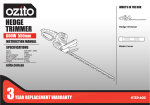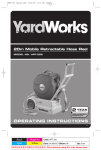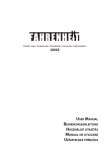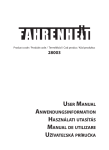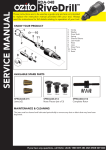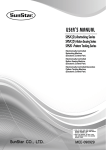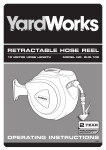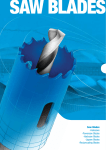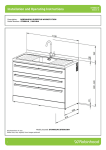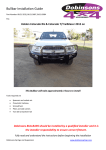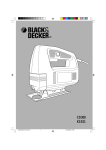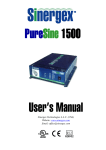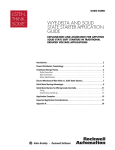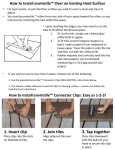Download CCG-381K Manual 1.qxd
Transcript
SPECIFICATIONS - MODEL NO. OZJS400A Motor: Input: No load speed: Stroke depth: Bevel: Blade fitment: 400W 230-240V ~ 50Hz 500 - 2,900 spm 18mm + / - 45° Bayonet Tool weight: Cutting capacities: 2.0kg Timber 55mm Mild steel 6mm Plastic 12mm KNOW YOUR PRODUCT 4 5 3 2 6 1 7 8 1. 2. 3. 4. Dust shield Variable speed dial On/off trigger switch Soft grip handle 5. 6. 7. 8. Switch lock on button Dust extraction adaptor Adjustable shoe Guide roller (for the blade) 1 TABLE OF CONTENTS SPECIFICATIONS ……………………………………….. Page 1 INTRODUCTION………………………………………… Page 3 ELECTRICAL SAFETY…………….………………………Page 3 GENERAL POWER TOOL SAFETY WARNINGS……… Page 4 JIGSAW SAFETY WARNINGS …………………….……Page 6 INSTALLATION ……………………………………………Page 7 OPERATION……………………………………………… Page 8 MAINTENANCE…………….…………………………… Page 11 PACK CONTENTS ……………………………………… Page 12 WARRANTY……………………………………………… Page 13 2 INTRODUCTION Congratulations on purchasing an Ozito Jigsaw. We aim to provide quality tools at an affordable price. We hope you will enjoy using this tool for many years. Your Ozito Jigsaw OZJS400A has been designed for cutting a variety of materials including timber, mild steel and plastic. It is intended for DIY use only. ! ELECTRICAL SAFETY ! WARNING! When using mains-powered tools, basic safety precautions, including the following, should always be followed to reduce risk of fire, electric shock, personal injury and material damage. Read the whole manual carefully and make sure you know how to switch the tool off, in an emergency, before operating the tool. Save these instructions and other documents supplied with this machine for future reference. The electric motor has been designed for 230V and 240V only. Always check that the power supply corresponds to the voltage on the rating plate. Note: The supply of 230V and 240V on Ozito tools are interchangeable for Australia and New Zealand. This tool is double insulated in accordance with AS/NZS60745-1; therefore no earth wire is required. If the supply cord is damaged, it must be replaced by a qualified electrician or a power tool repairer in order to avoid a hazard. Note: Double insulation does not take the place of normal safety precautions when operating this tool. The insulation system is for added protection against injury resulting from a possible electrical insulation failure within the tool. Using an extension lead Always use an approved extension lead suitable for the power input of this tool. Before use, inspect the extension lead for signs of damage, wear and ageing. Replace the extension lead if damaged or defective. When using an extension lead on a reel, always unwind the lead completely. Use of an extension lead not suitable for the power input of the tool or which is damaged or defective may result in a risk of fire and electric shock. 3 ! GENERAL POWER TOOL SAFETY WARNINGS ! WARNING! Read all safety warnings and all instructions. Failure to follow the warnings and instructions may result in electric shock, fire and/or serious injury. Save all warnings and instructions for future reference. The term “power tool" in the warnings refers to your mains-operated (corded) power tool or battery-operated (cordless) power tool. 1) Work area safety a) Keep work area clean and well lit. Cluttered or dark areas invite accidents. b) Do not operate power tools in explosive atmospheres, such as in the presence of flammable liquids, gases or dust. Power tools create sparks which may ignite the dust or fumes. c) Keep children and bystanders away while operating a power tool. Distractions can cause you to lose control. 2) Electrical safety a) Power tool plugs must match the outlet. Never modify the plug in any way. Do not use any adapter plugs with earthed (grounded) power tools. Unmodified plugs and matching outlets will reduce risk of electric shock. b) Avoid body contact with earthed or grounded surfaces, such as pipes, radiators, ranges and refrigerators. There is an increased risk of electric shock if your body is earthed or grounded. c) Do not expose power tools to rain or wet conditions. Water entering a power tool will increase the risk of electric shock. d) Do not abuse the cord. Never use the cord for carrying, pulling or unplugging the power tool. Keep cord away from heat, oil, sharp edges or moving parts. Damaged or entangled cords increase the risk of electric shock. e) When operating a power tool outdoors, use an extension cord suitable for outdoor use. Use of a cord suitable for outdoor use reduces the risk of electric shock. f) If operating a power tool in a damp location is unavoidable, use a residual current device (RCD) protected supply. Use of an RCD reduces the risk of electric shock. 3) Personal safety a) Stay alert, watch what you are doing and use common sense when operating a power tool. Do not use a power tool while you are tired or under the influence of drugs, alcohol or medication. A moment of inattention while operating power tools may result in serious personal injury. b) Use personal protective equipment. Always wear eye protection. Protective equipment such as dust mask, non-skid safety shoes, hard hat, or hearing protection used for appropriate conditions will reduce personal injuries. c) Prevent unintentional starting. Ensure the switch is in the off-position before connecting to power source and/or battery pack, picking up or carrying the tool. Carrying power tools with your finger on the switch or energising power tools that have the switch on invites accidents. 4 ! GENERAL POWER TOOL SAFETY WARNINGS (cont.) d) Remove any adjusting key or wrench before turning the power tool on. A wrench or a key left attached to a rotating part of the power tool may result in personal injury. e) Do not overreach. Keep proper footing and balance at all times. This enables better control of the power tool in unexpected situations. f) Dress properly. Do not wear loose clothing or jewellery. Keep your hair, clothing and gloves away from moving parts. Loose clothes, jewellery or long hair can be caught in moving parts. g) If devices are provided for the connection of dust extraction and collection facilities, ensure these are connected and properly used. Use of dust collection can reduce dust-related hazards. 4) Power tool use and care a) Do not force the power tool. Use the correct power tool for your application. The correct power tool will do the job better and safer at the rate for which it was designed. b) Do not use the power tool if the switch does not turn it on and off. Any power tool that cannot be controlled with the switch is dangerous and must be repaired. c) Disconnect the plug from the power source and/or the battery pack from the power tool before making any adjustments, changing accessories, or storing power tools. Such preventive safety measures reduce the risk of starting the power tool accidentally. d) Store idle power tools out of the reach of children and do not allow persons unfamiliar with the power tool or these instructions to operate the power tool. Power tools are dangerous in the hands of untrained users. e) Maintain power tools. Check for misalignment or binding of moving parts, breakage of parts and any other condition that may affect the power tool's operation. If damaged, have the power tool repaired before use. Many accidents are caused by poorly maintained power tools. f) Keep cutting tools sharp and clean. Properly maintained cutting tools with sharp cutting edges are less likely to bind and are easier to control. g) Use the power tool, accessories and tool bits etc. in accordance with these instructions, taking into account the working conditions and the work to be performed. Use of the power tool for operations different from those intended could result in a hazardous situation. 5) Service a) Have your power tool serviced by a qualified repair person using only identical replacement parts. This will ensure that the safety of the power tool is maintained. b) If the supply cord is damaged, it must be replaced by the manufacturer, its service agent or similarly qualified persons in order to avoid a hazard. 5 ! SAFETY INSTRUCTIONS FOR JIGSAWS 1. Hold power tool by insulated gripping surfaces when performing an operation where the cutting accessory may contact hidden wiring or its own cord. Cutting accessory contacting a “live” wire may make exposed metal parts of the power tool “live” and could give the operator an electric shock. 2. Remove all nails in the work piece before the jigsaw. Cutting nails may damage your tool. 3. Do not cut hollow pipe with the jigsaw 4. Do not cut material thicker or of a wider diameter than the specified limits. 5. Always allow enough clearance underneath the work piece to ensure the blade does not touch the floor or work bench, etc. 6. Hold the tool at a comfortable distance from your body. Do not over reach to access the work piece. 7. Do not touch moving parts with your fingers or hand. 8. Do not cut through walls or cavities without first checking for hidden electrical wires. 9. Ensure that you have tightened the blade prior to starting the machine. 10. When you have finished the cut, wait until the saw blade has stopped moving prior to removing it from the work piece. 11. Do not touch the saw blade immediately after use. Allow time for the blade to cool, as it may burn you due to the heat generated during sawing. 12. Always check accessories to ensure that they are suitable for the operating speeds of this tool. 13. Incorrect accessories can break apart at high speed and cause serious damage or injury. 6 INSTALLATION Inserting a blade 1. Before performing any adjustments ensure the tool has been switched off and is disconnected from any power supply. Fig. 1 2. Turn the Jigsaw upside down and slide the dust shield towards the shoe as far as it will go (Fig. 1). This makes it easier to access both of the blade securing bolts. 3. Remove the hex key from its holder and use this key to loosen the two blade securing bolts. The bolts can be accessed through the open slots in the dust shield (Fig. 2). Fig. 2 4. Before inserting the blade, ensure that the teeth of the blade face towards the front of the jigsaw (Fig. 3). Fig. 3 5. Then, insert the shaft end of the blade through the shoe into the blade holder (a). Looking through the dust shield (1), ensure that the shoulder of the bayonet (b) sits right at the base of the blade holder (a) (Fig. 4). Caution: Do not push the bayonet of the blade into the blade holder. As this can cause the shaft end of the blade to sit beyond the blade holder which can cause the motor to burn out. 6. Check that the back edge (non-serrated edge) of the blade is within the groove of the guide roller (8). If not, use the hex key to loosen the two bolts that secure the shoe and adjust the position of the shoe so that the back of the blade is firmly supported by the guide roller (8) (Fig. 5). Tighten the shoe locking screws. b Fig. 4 a Fig. 5 7. Return the dust shield into position. 8. Connect the Jigsaw to the power supply, switch on and check that the blade runs correctly. Switch off. 7 INSTALLATION (cont.) Removing a blade 1. Before performing any adjustments ensure the tool has been switched off and is disconnected from any power supply. 2. Turn the Jigsaw upside down, slide the dust shield towards the shoe and use the hex key to loosen the two blade securing bolts. 3. Remove the blade through the gap in the shoe. Adjusting the angle of the shoe 1. The shoe can be tilted to angles between 0º – 45º left or right so that you can cut bevel angles in a work piece. 2. Before performing any adjustments ensure the tool has been switched off and is disconnected from any power supply. 3. Turn the Jigsaw upside down and use the hex key to loosen the shoe locking screws that secure the shoe (refer back to Fig. 4). 4. Slide the shoe backwards away from the blade. Fig. 6 5. Tilt the shoe between 0 and 45° left or right. Bevel angles of 0, 15, 30 and 45° are marked on the bevel scale (Fig. 6). Once the angle has been set, slide the shoe forwards again and tighten the shoe locking screws. If an accurate bevel is required, it is best to check the setting with a protractor or by making a trial cut in a piece of scrap material and re-adjusting the setting if necessary (Fig. 7). 8 Fig. 7 OPERATION The tool is recommended for use with a residual current device with a rated residual current of 30mA or less. Turning the Jigsaw On/off To turn on the jigsaw, squeeze the trigger. To turn off, release the trigger. The tool can be locked on for continuous use by squeezing the trigger fully and depressing the lock button, gently release both the lock on button and the trigger, the tool will continue to operate. To turn the tool off from a locked on position, squeeze and release the trigger once. Caution: Do not unplug from the power supply with the switch in the locked on position. Always turn the tool off before disconnecting from the power supply. ! WARNING! A tool with the switch locked on will start immediately when plugged in to a live power supply. Always make sure the switch is in the released position prior to connecting the tool to a power supply. Variable Speed Dial The dial is incorporated into the trigger switch. The maximum speed of your tool can be changed by rotating the variable speed dial to the desired setting. The dial not only lets you select the speed to suit the job, but in doing so saves the blade from undue wear. The variable speed dial can be set so the maximum speed of the tool is limited anywhere from 500 - 2,900spm. Dust Extraction With the adaptor supplied the tool can be attached to most portable vacuum cleaners. To utilise this facility, connect the dust extraction adaptor to the dust extraction port at the rear of the jigsaw. Fit the vacuum hose in or over the adaptor, depending on the hose size. Note: The dust extraction system will only work when a house hold vacuum cleaner or dust extraction machine is connected to the tool as described above. Cutting It is recommended to first mark your intended cutting line with a pencil or appropriate marker. Start the tool and wait a short moment until the blade achieves maximum speed. Put the bottom of the base on the work piece and move forward slowly along the cutting line. Take extra care and time when cutting curved lines, this reduces stress on the blade and avoids blade breakage. ! WARNING! Let the tool work at its own pace. Do not overload. 9 OPERATION (cont.) Cutting Metal Your jigsaw can be used for cutting light gauge ferrous sheet and non-ferrous metals such as copper, brass, aluminium, etc. It is advisable when cutting sheet metal to clamp a backing sheet of soft wood or plywood to the work as this will enable you to obtain a clean cut without vibration and the possibility of tearing the metal. Both metal and wood backing are sawn together. Do not force the cutting blade into the metal as this will reduce the life of the blade and possibly damage the motor. Cutting thin metal will take longer than cutting even a relatively thick piece of wood, so do not be tempted to speed up the operation by forcing the saw. Spread a thin film of oil along the proposed cutting line before commencing to saw metal. Always select the right blade for the job. Pocket and Round Cutting When needing to start a cut from the centre of a work piece, drill a hole using a 12mm drill bit to allow the blade to pass through the hole in order to begin the cut. When cutting tight curves reduce the speed of the saw. 10 MAINTENANCE 1. After each use, blow air through the tool housing to ensure it is free from all dust particles that may build up. Build up of dust particles may cause the tool to overheat and fail. 2. If the enclosure of the tool requires cleaning do not use solvents but a moist soft cloth only. Never let any liquid get inside the tool; never immerse any part of the tool into a liquid. 3. When the carbon brushes wear out the tool will spark and/or stop. The brushes are a wearing component of the tool and should be replaced prior to the carbon wearing out fully. Brushes will wear out after many uses but before they do take the tool to an electrician or a power tool repairer for quick and low cost replacement. Always replace both brushes at the same time. Note: Ozito Industries will not be responsible for any damage or injuries caused by the repair of the tool by an unauthorised person or by mishandling of the tool. DESCRIPTION OF SYMBOLS V Volts Hz Hertz ~ Alternating current W Watts Revolutions or reciprocation per minute no No load speed spm Double insulated Regulator compliance mark Warning Maximum cutting cap for timber Read instruction manual Wear ear protection Wear eye protection Wear face mask 11 CARING FOR THE ENVIRONMENT Power tools that are no longer usable should not be disposed of with household waste but in an environmentally friendly way. Please recycle where facilities exist. Check with your local council authority for recycling advice. Recycling packaging reduces the need for landfill and raw materials. Reuse of recycled material decreases pollution in the environment. Please recycle packaging where facilities exist. Check with your local council authority for recycling advice. PACK CONTENTS 1 x Jigsaw OZJS400A 1 x Blade 1 x Dust extraction adaptor 1 x Allen key 1 x Instruction manual OZITO INDUSTRIES PTY LTD AUSTRALIA (Head Office) 1 - 23 Letcon Drive, Bangholme, Victoria, Australia 3175 Telephone: 1800 069 486 Facsimile: +61 3 9238 5588 Website: www.ozito.com.au Email: [email protected] 12 WARRANTY YOUR WARRANTY FORM SHOULD BE RETAINED BY YOU AT ALL TIMES. IN ORDER TO MAKE A CLAIM UNDER THIS WARRANTY YOU MUST RETURN THE PRODUCT TO YOUR NEAREST BUNNINGS WAREHOUSE WITH YOUR BUNNINGS REGISTER RECEIPT. PRIOR TO RETURNING YOUR PRODUCT FOR WARRANTY PLEASE TELEPHONE OUR CUSTOMER SERVICE HELPLINE: `Australia 1800 069 486 New Zealand 0508 069 486 TO ENSURE A SPEEDY RESPONSE PLEASE HAVE THE MODEL NUMBER AND DATE OF PURCHASE AVAILABLE. A CUSTOMER SERVICE REPRESENTATIVE WILL TAKE YOUR CALL AND ANSWER ANY QUESTIONS YOU MAY HAVE RELATING TO THE WARRANTY POLICY OR PROCEDURE. The benefits provided under this warranty are in addition to other rights and remedies which are available to you at law. Our goods come with guarantees that cannot be excluded at law. You are entitled to a replacement or refund for a major failure and for compensation for any other reasonably foreseeable loss or damage. You are also entitled to have the goods repaired or replaced if the goods fail to be of acceptable quality and the failure does not amount to a major failure. Generally you will be responsible for all costs associated with a claim under this warranty, however, where you have suffered any additional direct loss as a result of a defective product you may be able to claim such expenses by contacting our customer service helpline above. 3 YEAR REPLACEMENT WARRANTY Your product is guaranteed for a period of 36 months from the original date of purchase and is intended for DIY (Do It Yourself) use only. If a product is defective it will be replaced in accordance with the terms of this warranty. Warranty excludes consumable parts, for example: saw blades, dust extraction adaptor, carbon brushes. WARNING The following actions will result in the warranty being void. • • • • • Professional, Industrial or high frequency use. If the tool has been operated on a supply voltage other than that specified on the tool. If the tool shows signs of damage or defects caused by or resulting from abuse, accidents or alterations. Failure to perform maintenance as set out within the instruction manual. If the tool is disassembled or tampered with in any way. OZITO Australia/New Zealand (Head Office) 1-23 Letcon Drive, Bangholme, Victoria, Australia 3175 OW5














